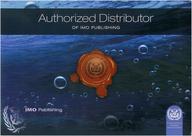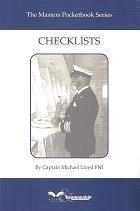Catálogo - LIBROS NÁUTICOS - Miscelánea
The Masters pocketbook series - Checklists
Autor: Michael Lloyd
Editorial: Witherby
Año de edición: 2.009 (1ª edición)
9781905331444
Encuadernación: rústica
224 pág.
12,0 x 18,0 cm.
28,50€
Contenido:
The checklists can be adapted to suit whatever circumstances and personnel exist onboard ensuring maximum efficiency, safety and a continuation of command during handover.
The purpose of Captain Lloyd’s book ‘Checklists’ is to attempt to lay down basic procedures for all ranks (Masters in particular) based on the premise that shipboard life is in a constant state of change/flux as crew join and leave and new procedures are implemented. But how does one ensure that critical things don’t get missed in this environment? Captain Lloyd seeks to use his vast experience as Master to identify areas of the Captain’s remit that can benefit from having sensible, articulated procedures in place.
The format of the book is critically important to achievement of its stated goals – that is easily referenced and pocket sized.
This book actually dovetails with many of the procedures laid down in various ship managers’ ‘Bridge Team Command and Control Standards’ programmes that have standardised all watch handover checklists and communications procedures throughout fleets. This should ensure that, however often crew changes occur, the ship should always operate to the same standards and procedures.
The book clearly fills a gap in the market. The quality of standardised procedures/checklists still varies across different companies and this can create ‘dead zones’ through which important checks can be missed.
This leads onto the key points about this book. While not stating it in his introduction, the book is surreptitiously about the need to ensure good communication between all appropriate personnel onboard. Almost every checklist includes an item about disseminating information to crew members, port agents or shore side authorities, and highlights the fact that one of the Master’s overriding responsibilities is to ensure that everyone is on the same page at all times during operations.
The second key point is that the book shows the Master how to delegate. While not drawing specific attention to this in the book, the checklists always include a section on who to delegate a particular operation to. Many Captains’ are promoted to command with little formal (if any) training of people management. The inability to be an effective delegate can cause confusion and upset the smooth operation of the crew routines, as individuals do not know where they stand if the Captain meddles every five minutes.
The third key point to draw from the book is the need to maintain increasingly stringent records to deal with increased litigation. In this modern age of shipping, it is important that each and every officer ensures that a paper trail (for example documenting regular safety meetings in a formal manner) maintenance and log keeping takes place to ensure that accountability can be determined. ‘Checklists’ should ensure that procedures are implemented to assist in this.
Additional information provided in the book actually suggests that the book has a slightly broader remit than simply checklists. For example, the advice on ensuring that drills are creative and varied is outside of a conventional ‘checklist’ format. However, this is important information to document in a book such as this as, too often, drills are 2 dimensional and simulate only the most mundane of potential emergency situations (and often the easiest to deal with using conventional training). The book encourages Masters to ask ‘What If’ when considering different emergency response training. This is excellent advice; especially with merchant ships becoming increasingly specialised and complex.
Laying out checklists on procedures for subjects such as dealing with death onboard is also very important as it allows the Master to ensure that they can appear competent and totally in control in front of a potentially distraught crew.
The diversity of chapters is impressive and acts as a useful aide memoir. However, as with all similar books, there is question mark regarding what information to leave out. For example, the disciplinary procedures chapter would benefit from more information regarding the processes that must be followed to ensure an effective disciplinary procedure. This is such a critical issue that so many officers have poor working knowledge of, that an effective checklist would act as a useful tool. On the other hand, one could argue that the space could be created by removing readily available information such as duplicated MGNs or information found in the Bridge Procedures Guide.
In summary, this book is at its most effective when it stays ‘on mission’. That is to say that checklists regarding necessary documentation required prior to departure or what to do in the event of an ODME failure are such useful additional tools to have because this information is often not available elsewhere in summarised ‘checklist ‘ format.
Índice:
Author´s introduction
1. SAFETY ITEMS
1.1. Departmental responsibilities
1.2. Safet equipment on deck
1.2.1. Maintenance
1.2.2. Defects
1.3. Safety equipment in the engine room
1.3.1. Maintenance
1.3.2. Defects
1.4. Safety stores / safety spares
1.5. Safety surveys
1.6. Shipboard safety meetings
1.7. Drills and exercises
1.8. Training
1.9. Port state control and other safety inspections
1.10. Accident prevention and new crew safety induction
1.11. Accidents
2. POLLUTION
2.1. Responsibilities
2.2. Garbage
2.2.1. Responsibilities
2.2.2. Garbage disposal
2.2.3. Pollution from garbage
2.3. Bunkering
2.3.1. Bunkering checklist (before transfer)
2.4. Oil pollution from an oil tanker
2.4.1. Oil spilled on deck
2.4.2. Pumproom spillage
2.4.3. Oil pollution of unknown origin
2.5. Other sources of pollution
2.5.1. Sewage
2.5.2. Ballast water
2.5.3. Air pollution
2.6. Evidence to be collected in the event of a pollution incident
3. MEDICAL
3.1. Responsibilities
3.2. Treatment
3.3. Injury, illness or death
3.3.1. Injury
3.3.2. Illness
3.3.3. Death
3.4. Drugs and alcohol
3.4.1. General
3.4.2. Drug use onboard
3.4.3. Measures to prevent drug smuggling
3.4.4. If drugs are found
3.4.5. Alcohol
4. NAVIGATION
4.1. Responsibilities
4.2. Passage planning
4.3. Communications
4.3.1. GMDSS log book entries
4.4. Equipment maintenance
4.5. Emergency situation procedures
4.6. Flags
4.7. Helicopter transfer - planned operation
4.7.1. Prior to helicopter operations
4.7.2. On helicopter approach
4.7.3. Deck preparation
4.7.4. PPE
4.8. MGN 315 (Keeping a Safe Navigational Watch on Merchant Vessels)
4.9. Other considerations
4.9.1. Unsafe port - unsafe berth
4.9.2. Sailing on a critical RPM for a prolonged period of time
4.9.3. Sufficient tug assistance
4.9.4. Parametric/synchronous rolling
5. CARGO
5.1. Responsibilities
5.2. Voyage orders
5.2.1. Dry cargo carriers
5.2.2. Tankers
5.3. Cargo records
5.3.1. Oil tankers
5.3.2. Bulk and general cargo ships
5.3.3. The cargo log
5.4. Cargo loading
5.5. Discharge
5.6. Cargo checklists - oil tankers
5.6.1. Arrival at a terminal using a Vapour Emission Control System (VECS)
5.6.2. Cargo valve failure
5.6.3. Failure of Inert Gas System (IGS)
5.6.4. Oil discharge monitoring equipment (ODME) failure
5.7. Signing Bills of Lading (B/L) - Letters of Indemnity
6. MEETINGS
6.1. Safety committee meetings
6.2. General guidelines
7. COMMUNICATIONS
7.1. Repairs and surveys
7.2. Administration
7.2.1. Responsibilities
7.2.2. Administrative functions
8. ACCOMMODATION
8.1. Hotel services
8.2. Working hours and overtime
8.3. Cleanliness
8.3.1. Ratings´quarters
8.3.2. Inspections
8.4. Victualling
8.5. Laundry
8.6. Stores
9. PERSONNEL
9.1. Joining procedure
9.2. New joiner induction
9.2.1. Deck officers
9.2.2. Catering
9.3. Crew qualifications and documentation
9.3.1. Crew qualifications
9.3.2. Crew documentation
9.3.3. Crew competency
9.3.4. Crew fitness
9.3.5. Crew fatigue
9.4. Leaving procedure
10. DISCIPLINE
10.1. Responsibilities
10.2. Ratings
10.3. Officers
10.4. Disciplinary procedure
11. ISM AND ISPS CODES
11.1. Responsibilities
11.2. ISM management
11.3. ISPS code checklists
11.3.1. Ship´s security level 1
11.3.2. Ship´s security level 2
11.3.3. Ship´s security level 3
11.4. Checklist to prevent intruders (stowaways)
11.5. Crew identity
12. STEERING GEAR AND ENGINE TESTS
12.1. Responsibilities
12.2. Steering test at sea
12.3. Steering test in port
12.4. Engine tests at sea
12.5. Engine tests in port
13. BALLAST WATER MANAGEMENT
14. STANDING ORDERS
14.1. Standing orders (sea)
14.1.1. Responsibilities
14.1.2. Standing orders
14.1.3. Under pilotage
14.2. Standing orders (port)
15. PREPARATION FOR PORT ARRIVAL
15.1. Port arrival
15.1.1. Shipboard preparation
15.1.2. If anchoring
15.1.3. Information to pass to the agent
15.1.4. Berth check
15.1.5. Port documentation
15.1.6. Documentation
15.2. Port departure
15.3. Preparing for port departure
16. INSURANCE AND P&I CLUBS
16.1. P&I insurance
16.2. Letter of undertaking
16.3. Fines
17. NON-STANDARD ITEMS
17.1. Confined space entry checklist
17.2. War zones
17.2.1. War zone checklist
17.3. Piracy
17.3.1. Action points onboard
17.4. Hot work in cargo oil tanks
17.5. Heavy weather (port)
17.6. Heavy weather (sea)
17.7. Freezing conditions
17.7.1. Checklist for the deck department
17.7.2. Checklist for the engine department
17.7.3. Ice accretion
17.8. Refugees
17.9. Stowaways
18. HANDOVER ARRIVING/LEAVING
18.1. Handover notes for incoming master
18.2. Transferring command
18.3. Certificates/Documents required to be carried onboard ships
18.3.1. On all ships
18.3.2. Passenger ships
18.3.3. Cargo ships
18.3.4. Ships carrying noxious liquid chemical substances in bulk
18.3.5. Chemical tanker
18.3.6. Liquefied gas carriers
18.3.7. High-speed craft
18.3.8. Ships carrying dangerous goods
18.3.9. Ships carrying dangerous goods in packaged form
18.4. On taking over
19. EMERGENCY CHECKLIST
19.1. Collision
19.1.1. After the event
19.2. Grounding
19.2.1. Records after a grounding
19.3. Man overboard
19.4. Fire
19.5. Dangerous goods incident
19.6. Cargo shift
19.7. Salvage/Search and Rescue (SAR)
19.7.1. Records when salvor in attendance
19.8. Medical
19.9. Helicopter operations
19.10. Pollution incident (oil tanker)
19.11. Abandon ship
19.12. Angle of loll
Index
Precio: 28,50 €, I.V.A. incluido (4%)
[ Volver ]


